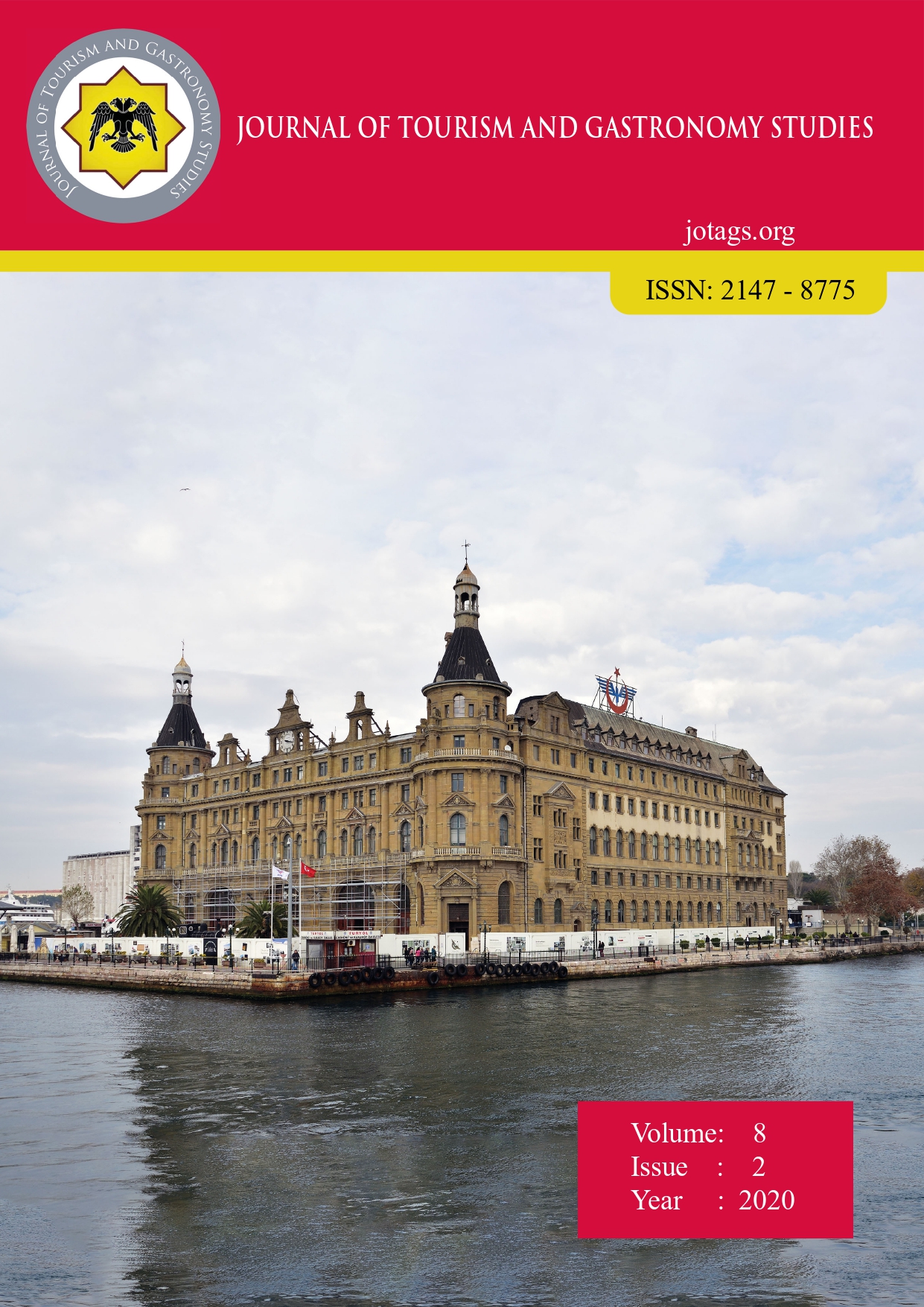Lisans Düzeyinde Turizm Eğitimi Alan Öğrencilerin Çevre Kimliklerinin Belirlenmesine Yönelik Bir Araştırma (A Research on Determination of Environmental Identities of Undergraduate Students Studying Tourism)
DOI:
https://doi.org/10.21325/jotags.2020.602Keywords:
Environment, Environmental identity, Tourism studentsAbstract
The purpose of this research is to determine the environmental identity of students who are studying undergraduate tourism. Within the scope of the research, it is also aimed to detect the differences in the department (tourism management, gastronomy and culinary arts and tourism guidance department), gender and class. In order to determine the internal consistency of the items in the environmental identity scale, reliability analysis was performed. As a result of the analysis, it was determined that the reliability value of the environmental identity scale was 88,2% (α=0,882). As a result of the applied Kruskal-Wallis test, a significant difference was found between the environmental identity of the students and the department they read (p=0,044<0,05) and their classes (p=0,000<0,05). As a result of the Mann-Whitney U Test conducted to determine whether there are statistically significant differences between the genders and the environmental identities of the students, a significant difference (p=0,000<0,05) was detected between the genders and the environmental identities of the students. According to the test result, it is possible to comment that female students have a stronger environmental identity than male students. In addition, in the results of the descriptive analysis of the environmental identity scale, the mean of the environmental identity scale was X̄ =5,394, ss= 0,824. These results show that tourism students have a strong environmental identity.
References
Ajzen, I., & Fishbein, M. (1980). Understanding attitudes and predicting social behavior. Englewood Cliffs, NJ, USA: Prentice-Hall.
Ak, S. (2008). Search of primary school teacher candidates’ towards enviromental consciousness due some demographic variables (Unpublished master’s thesis, Abant Izzet Baysal University, Bolu, Turkey).
Altunışık, R., Coşkun, R., Bayraktaroğlu, S., & Yıldırım, E. (2012). Sosyal bilimlerde araştırma yöntemleri: SPSS uygulamalı (7. Baskı). Adapazarı: Sakarya Yayıncılık.
Barton, A. C., & Yang, K. (2000). The culture of power and science education: Learning from Miguel. Journal of Research in Science Teaching. The Official Journal of the National Association for Research in Science Teaching, 37(8), 871-889.
Biddle, B. J., Bank, B. J., Anderson, D. S., Hauge, R., Keats, D. M., Keats, J. A, & Valantin, S. (1985). Social influence, self‐referent identity labels, and behavior. Sociological Quarterly, 26(2), 159-185.
Biddle, B. J., Bank, B. J., & Slavings, R. L. (1987). Norms, preferences, identities and retention decisions. Social Psychology Quarterly, 50(4), 322-337.
Blatt, E. N. (2013). Exploring environmental identity and behavioral change in an Environmental Science course. Cultural Studies of Science Education, 8(2), 467-488.
Blatt, E. (2014). Uncovering students’ environmental identity: An exploration of activities in an environmental science course. The Journal of Environmental Education, 45(3), 194-216.
Burke, P. J. (1991). Identity processes and social stress. American Sociological Review, 56(6), 836-849.
Burke, P. J., & Reitzes, D. C. (1981). The link between identity and role performance. Social Psychology Quarterly, 44(2), 83-92.
Buttel, F. H. (1987). New directions in environmental sociology. Annual Review of Sociology, 13(1), 465-488.
Charng, H. W., Piliavin, J. A., & Callero, P. L. (1988). Role identity and reasoned action in the prediction of repeated behavior. Social Psychology Quarterly, 51(4), 303-317.
Clayton, S. (2003). Environmental identity: A conceptual and an operational definition. Identity and the natural environment: The psychological significance of nature. London: The MIT Press.
Clayton, S. D. (2012). The Oxford handbook of environmental and conservation psychology. New York, USA: Oxford Universtiy Press.
Clayton, S., & Kilinç, A. (2013). Proenvironmental concern and behavior in Turkey: The role of national and environmental identity. PsyEcology, 4(3), 311-330.
Clayton, S., & Opotow, S. (2003). Introduction: Identity and the natural environment. In Clayton, S., & Opotow S. (Eds.), Identity and the natural environment (pp. 1-24). London, England: MIT Press.
Cobern, W. W. (2000). Everyday thoughts about nature: A worldview investigation of important concepts students use to make sense of nature with specific attention of science. Boston, USA: Kluwer Academic Publishers.
Cobern, W. W., Gibson, A. T., & Underwood, S. A. (1999). Conceptualizations of nature: An interpretive study of 16 ninth graders' everyday thinking. Journal of Research in Science Teaching: The Official Journal of the National Association for Research in Science Teaching, 36(5), 541-564.
Cortina, J. M. (1993). What is coefficient alpha? An examination of theory and applications. Journal of Applied Psychology, 78(1), 98–104.
Décamps, H. (2000). Demanding more of landscape research (and researchers). Landscape and Urban Planning, 47(3-4), 105-109.
Dindar, Y. (2014). Çevre kimliği yüksek ve düşük olan fen bilimleri öğretmenlerinin çevre eğitimi inançlarının kıyaslanması (Unpublished master’s thesis, Abant Izzet Baysal University, Bolu, Turkey).
Dunlap, R. E., & Van Liere, K. D. (1978). The “new environmental paradigm”. The Journal of Environmental Education, 9(4), 10-19.
Eren, B., & Yaqub, M. (2015). Environmental consciousness survey of university students. 3rd International Symposium on Innovative Technologies in Engıneering and Science, Conference Paper ISITES2015 (pp 375-385). Akademik Platform, Valencia, Spain.
Freed, A., & Wong, D. (2019). The relationship between university students’ environmental ıdentity, decision-making process, and behavior. Journal of Sustainability Education, 20, 1-23.
Gülgün, B., Önder, S., Aktaş, E., & Ünal Ankaya, F. (2008). Responses of university students related to environmental problems: A case study of Ege University (Izmir-Turkey). J. Int. Environmental Application & Science, 3(4), 234-246.
Heberlein, T. A. (2012). Navigating environmental attitudes. New York, USA: Oxford University Press.
Jaksha, A. P. (2013). Environmental identity: A new approach to understanding students' participation in environmental learning programs (PhD Thesis, The University of Arizona, Tucson, USA).
Kashima, Y., Paladino, A., & Margetts, E. A. (2014). Environmentalist identity and environmental striving. Journal of Environmental Psychology, 38, 64-75.
Kempton, W., & Holland, D. C. (2003). Identity and sustained environmental practice. Identity and the natural environment: the psychological significance of nature. London, England: The MIT Press.
Kiesling, F. M., & Manning, C. M. (2010). How green is your thumb? Environmental gardening identity and ecological gardening practices. Journal of Environmental Psychology, 30(3), 315-327.
Kışoğlu, M., Gürbüz, H., Sülün, A., Alaş, A., & Erkol, M. (2010). Environmental literacy and evaluation of studies conducted on environmental literacy in Turkey. International Online Journal of Educational Sciences, 2(3), 772-791.
Kollmuss, A., & Agyeman, J. (2002). Mind the Gap: Why do people act environmentally and what are the barriers to pro-environmental behavior? Environmental Education Research, 8(3), 239-260.
Mayer, F. S., & Frantz, C. M. (2004). The connectedness to nature scale: A measure of individuals’ feeling in community with nature. Journal of Environmental Psychology, 24(4), 503-515.
Ogueri, A. C. (2004). The need for environmental education in secondary education level in Nigeria: problems and challenges (Unpublished master’s thesis, Environmental policy department of environment, technology and social studies, Roskilde University, Roskilde, Denmark).
Oğuz D., Çakıcı, I., & Kavas, S. (2011). Yüksek öğretimde öğrencilerin çevre bilinci, SDÜ Orman Fakültesi Dergisi, 12, 34-39.
Öztarakçı, D. (2019). Öğretmen adaylarının çevre dostu davranışları ve çevre kimlikleri (Yayınlanmamış Yüksek Lisans Tezi, Fen Bilimleri Enstitüsü, Balıkesir Üniversitesi, Balıkesir, Türkiye).
Payne, P. (2001). Identity and environmental education. Environmental Education Research, 7(1), 67-88.
Prévot, A. C., Clayton, S., & Mathevet, R. (2018). The relationship of childhood upbringing and university degree program to environmental identity: Experience in nature matters. Environmental Education Research, 24(2), 263-279.
Samuelson, C., Peterson, T. R., & Putnam, L. (2003). Group identity and stakeholder conflict in water resource management. In S. Clayton and S. Opotow (Eds.), Identity and the natural environment (pp. 273-295). Londan, England: MIT Press.
Stapleton, S. R. (2015). Environmental identity development through social interactions, action, and recognition, The Journal of Environmental Education, 46(2), 94-113.
Stern, P. C., Kalof, L., Dietz, T., & Guagnano, G. A. (1995). Values, beliefs, and proenvironmental action: Attitude formation toward emergent attitude objects 1. Journal of applied social psychology, 25(18), 1611-1636.
Stets, J. E., & Biga, C. F. (2003). Bringing identity theory into environmental sociology. Sociological Theory, 21(4), 398-423.
Stren, P. C. (2000). Toward a coherent theory of environmentally significant behaviour. Journal of Social Issues, 56(3), 407-424.
Stryker, S., & Burke, P. J. (2000). The past, present, and future of an identity theory. Social psychology quarterly, 63(4), 284-297.
Stryker, S. (2004). Integrating emotion into identity theory. Advances in group Processes, 21, 1-23.
Kiesling, F. M., & Manning, C. M. (2010). How green is your thumb? Environmental gardening identity and ecological gardening practices. Journal of Environmental Psychology, 30(3), 315-327.
Kışoğlu, M., Gürbüz, H., Sülün, A., Alaş, A., & Erkol, M. (2010). Environmental literacy and evaluation of studies conducted on environmental literacy in Turkey. International Online Journal of Educational Sciences, 2(3), 772-791.
Kollmuss, A., & Agyeman, J. (2002). Mind the Gap: Why do people act environmentally and what are the barriers to pro-environmental behavior? Environmental Education Research, 8(3), 239-260.
Mayer, F. S., & Frantz, C. M. (2004). The connectedness to nature scale: A measure of individuals’ feeling in community with nature. Journal of Environmental Psychology, 24(4), 503-515.
Ogueri, A. C. (2004). The need for environmental education in secondary education level in Nigeria: problems and challenges (Unpublished master’s thesis, Environmental policy department of environment, technology and social studies, Roskilde University, Roskilde, Denmark).
Oğuz D., Çakıcı, I., & Kavas, S. (2011). Yüksek öğretimde öğrencilerin çevre bilinci, SDÜ Orman Fakültesi Dergisi, 12, 34-39.
Öztarakçı, D. (2019). Öğretmen adaylarının çevre dostu davranışları ve çevre kimlikleri (Yayınlanmamış Yüksek Lisans Tezi, Fen Bilimleri Enstitüsü, Balıkesir Üniversitesi, Balıkesir, Türkiye).
Payne, P. (2001). Identity and environmental education. Environmental Education Research, 7(1), 67-88.
Prévot, A. C., Clayton, S., & Mathevet, R. (2018). The relationship of childhood upbringing and university degree program to environmental identity: Experience in nature matters. Environmental Education Research, 24(2), 263-279.
Samuelson, C., Peterson, T. R., & Putnam, L. (2003). Group identity and stakeholder conflict in water resource management. In S. Clayton and S. Opotow (Eds.), Identity and the natural environment (pp. 273-295). Londan, England: MIT Press.
Stapleton, S. R. (2015). Environmental identity development through social interactions, action, and recognition, The Journal of Environmental Education, 46(2), 94-113.
Stern, P. C., Kalof, L., Dietz, T., & Guagnano, G. A. (1995). Values, beliefs, and proenvironmental action: Attitude formation toward emergent attitude objects 1. Journal of applied social psychology, 25(18), 1611-1636.
Stets, J. E., & Biga, C. F. (2003). Bringing identity theory into environmental sociology. Sociological Theory, 21(4), 398-423.
Stren, P. C. (2000). Toward a coherent theory of environmentally significant behaviour. Journal of Social Issues, 56(3), 407-424.
Stryker, S., & Burke, P. J. (2000). The past, present, and future of an identity theory. Social psychology quarterly, 63(4), 284-297.
Stryker, S. (2004). Integrating emotion into identity theory. Advances in group Processes, 21, 1-23.
Tekin, E. (2012). Environmental awareness and concerns of pre-service teachers in a private non-profit university (PhD thesis, Bilkent University, Ankara, Turkey).
Thapa, B. (2001). Environmental concern: A comparative analysis between students in recreation and park management and other departments. Environmental Education Research, 7(1), 39-53.
Tugurian, L. P., & Carrier, S. J. (2017) Children's environmental identity and the elementary science classroom, The Journal of Environmental Education, 48(3), 143-153.
Uzunsakal, E., & Yıldız, D. (2018). Alan araştırmalarında güvenilirlik testlerinin karşılaştırılması ve tarımsal veriler üzerine bir uygulama. Uygulamalı Sosyal Bilimler Dergisi, 2(1), 14-28.
Weigel, R., & Weigel, J. (1978). Environmental concern: The development of a measure. Environment and behavior, 10(1), 3-15.
Weigert, A. J. (1997). Self, interaction, and natural environment: Refocusing our eyesight. New York, USA: State University of New York Press.
Whitmarsh, L., & O'Neill, S. (2010). Green identity, green living? The role of pro-environmental self-identity in determining consistency across diverse pro-environmental behaviours. Journal of Environmental Psychology, 30(3), 305-314.
Williams, C. C., & Chawla, L. (2016). Environmental identity formation in nonformal environmental education programs. Environmental Education Research, 22(7), 978-1001.
Yazıcıoğlu, Y., & Erdoğan, S. (2004). SPSS uygulamalı bilimsel araştırma yöntemleri. Ankara, Türkiye: Detay Yayıncılık.
Zavestoski, S. (2003). Constructing and maintaining ecological identities: The strategies of deep ecologists. Identity and the natural environment: The psychological significance of nature. London, England: The MIT Press.
Published
How to Cite
Issue
Section
License
Copyright (c) 2023 Journal of Tourism & Gastronomy Studies

This work is licensed under a Creative Commons Attribution-NonCommercial 4.0 International License.








